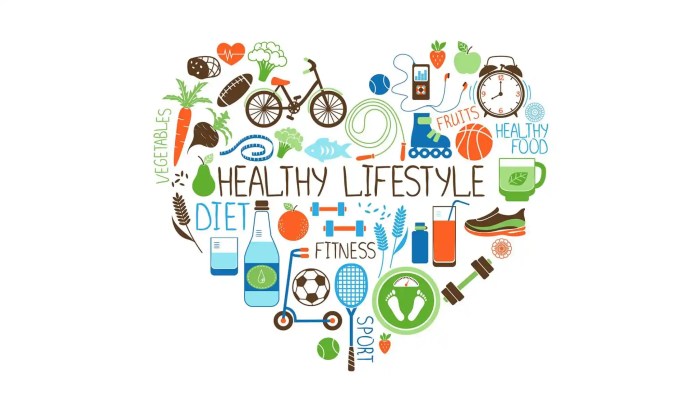Tips for a Balanced Lifestyle

Tips for a balanced lifestyle encompass more than just diet and exercise; it’s a holistic approach to well-being. This guide explores practical strategies for nourishing your body, mind, and spirit, covering everything from mindful eating and stress management techniques to prioritizing sleep and incorporating technology for wellness. We’ll delve into creating a sustainable routine that promotes physical and mental health, ultimately empowering you to live a more fulfilling and balanced life.
Through detailed plans, actionable advice, and insightful discussions, we aim to equip you with the knowledge and tools necessary to cultivate a healthier and happier you. We’ll examine the interconnectedness of various lifestyle factors and how they contribute to overall well-being, offering a comprehensive roadmap to achieving a harmonious balance in all aspects of your life.
Nutrition for a Balanced Lifestyle: Tips For A Balanced Lifestyle

A balanced diet is crucial for maintaining a healthy lifestyle. It provides the necessary nutrients to support physical and mental well-being, boosting energy levels, improving mood, and strengthening the immune system. Focusing on nutrient-rich foods and mindful eating habits are key components of achieving this balance.
A Balanced Daily Diet Plan
A well-balanced diet incorporates all essential food groups in appropriate proportions. The following table illustrates a sample daily plan, adaptable to individual needs and preferences. Remember to adjust portion sizes based on your activity level and caloric needs.
| Breakfast | Lunch | Dinner | Snacks |
|---|---|---|---|
| Oatmeal with berries and nuts, a glass of milk | Salad with grilled chicken or fish, whole-grain bread | Baked salmon with roasted vegetables and brown rice | Fruits (apple, banana), yogurt, handful of almonds |
| Scrambled eggs with spinach and whole-wheat toast | Lentil soup with a side of whole-wheat crackers | Chicken stir-fry with brown rice and mixed vegetables | Vegetables (carrots, celery) with hummus, a small portion of trail mix |
| Greek yogurt with granola and fruit | Turkey and avocado sandwich on whole-grain bread | Vegetarian chili with cornbread | Hard-boiled egg, a small piece of fruit |
| Smoothie with fruits, vegetables, and protein powder | Leftovers from dinner | Lean beef with sweet potato and green beans | Air-popped popcorn |
Balanced Meal Recipes, Tips for a balanced lifestyle
The following recipes illustrate balanced meals incorporating various food groups:
- Quinoa Salad with Roasted Vegetables: This salad combines protein-rich quinoa with a variety of colorful roasted vegetables (bell peppers, zucchini, broccoli) and a lemon-herb vinaigrette. Nutritional Information (per serving): Approximately 400 calories, 15g protein, 60g carbohydrates, 10g fat. This provides a good balance of macronutrients and micronutrients from the vegetables.
- Chicken and Vegetable Stir-fry: Lean chicken breast stir-fried with a medley of vegetables (broccoli, carrots, snap peas) in a light soy sauce-based stir-fry. Serve over brown rice. Nutritional Information (per serving): Approximately 350 calories, 30g protein, 40g carbohydrates, 10g fat. The chicken provides protein, while the vegetables offer vitamins and minerals.
- Lentil Soup with Whole-Wheat Bread: A hearty and nutritious lentil soup packed with fiber and protein. Serve with a slice of whole-wheat bread for added carbohydrates. Nutritional Information (per serving): Approximately 300 calories, 15g protein, 50g carbohydrates, 5g fat. Lentils are an excellent source of plant-based protein and fiber.
- Baked Salmon with Roasted Asparagus: Baked salmon, a rich source of omega-3 fatty acids, paired with roasted asparagus, a good source of vitamins and minerals. Nutritional Information (per serving): Approximately 450 calories, 35g protein, 20g carbohydrates, 25g fat. Salmon provides healthy fats and protein, while asparagus offers vitamins and antioxidants.
- Turkey and Avocado Sandwich on Whole-Wheat Bread: A lean protein source (turkey) combined with healthy fats (avocado) and complex carbohydrates (whole-wheat bread). Nutritional Information (per serving): Approximately 350 calories, 25g protein, 40g carbohydrates, 15g fat. This provides a balanced mix of macronutrients and healthy fats.
Mindful Eating and Well-being
Mindful eating involves paying attention to your body’s hunger and fullness cues, savoring each bite, and eating without distractions. This practice helps regulate appetite, improve digestion, and foster a healthier relationship with food. By being present during meals, you’re more likely to recognize satiety signals, preventing overeating and promoting healthier food choices. This conscious approach to eating contributes to overall well-being by reducing stress and improving mental clarity.
Regular mindful eating practices can lead to better weight management, reduced emotional eating, and increased appreciation for the food you consume.
Stress Management Techniques

Stress is an unavoidable part of modern life, but chronic stress can significantly impact our physical and mental well-being. Learning effective stress management techniques is crucial for maintaining a balanced lifestyle and preventing health problems. This section explores several strategies to help you navigate stressful situations and cultivate a sense of calm.
Five Effective Stress Management Techniques
Managing stress effectively involves understanding its root causes and employing strategies that suit your individual needs and preferences. The following techniques offer diverse approaches to reducing stress levels and promoting overall well-being.
- Mindfulness Meditation: Mindfulness involves focusing on the present moment without judgment. Through regular practice, it enhances self-awareness, reduces rumination, and promotes emotional regulation. A practical example is setting aside 10-15 minutes daily to sit quietly, focusing on your breath and observing your thoughts and feelings without getting carried away by them.
- Progressive Muscle Relaxation: This technique involves systematically tensing and releasing different muscle groups in your body. By consciously releasing tension, you can reduce physical manifestations of stress and promote a sense of relaxation. A practical application would be starting with your toes, tensing them for a few seconds, then releasing, and slowly moving up your body, tensing and releasing each muscle group in turn.
- Deep Breathing Exercises: Deep, slow breathing activates the parasympathetic nervous system, which helps to counter the effects of the stress response. Practicing diaphragmatic breathing, where your abdomen expands with each inhale, can significantly reduce heart rate and blood pressure. A simple exercise involves inhaling deeply through your nose, holding for a few seconds, and exhaling slowly through your mouth, repeating this several times.
- Regular Physical Activity: Exercise is a powerful stress reliever. Physical activity releases endorphins, which have mood-boosting effects, and helps to reduce muscle tension and improve sleep quality. Engaging in at least 30 minutes of moderate-intensity exercise most days of the week, such as brisk walking, swimming, or cycling, can make a substantial difference.
- Time Management and Prioritization: Feeling overwhelmed often stems from poor time management. Prioritizing tasks, breaking down large projects into smaller, manageable steps, and learning to say no to non-essential commitments can significantly reduce stress levels. Using tools like planners, to-do lists, or time-blocking techniques can be highly beneficial.
Comparison of Relaxation Techniques
Different relaxation techniques offer unique approaches to stress reduction. The following table compares and contrasts meditation, deep breathing, and yoga.
| Technique | Mechanism | Benefits | Implementation |
|---|---|---|---|
| Meditation | Focuses attention on the present moment, reducing mind-wandering and promoting self-awareness. | Reduces anxiety, improves focus, enhances emotional regulation. | Find a quiet space, focus on breath or a mantra, practice regularly for 10-20 minutes. |
| Deep Breathing | Activates the parasympathetic nervous system, slowing heart rate and reducing blood pressure. | Reduces anxiety, improves sleep, promotes relaxation. | Inhale deeply through nose, exhale slowly through mouth, focus on abdominal expansion. |
| Yoga | Combines physical postures, breathing techniques, and meditation to promote physical and mental well-being. | Improves flexibility, strength, reduces stress, improves balance and coordination. | Attend classes or follow online tutorials, focus on proper form and breathing. |
Stress and Physical Health
Chronic stress significantly impacts physical health. The body’s prolonged stress response, involving the release of cortisol and other stress hormones, can weaken the immune system, increasing susceptibility to illness. Potential health risks associated with chronic stress include cardiovascular disease (high blood pressure, heart attacks, strokes), gastrointestinal problems (irritable bowel syndrome, ulcers), weakened immunity, sleep disturbances, and mental health issues such as anxiety and depression.
For example, individuals under prolonged job-related stress often experience higher rates of heart disease due to elevated cortisol levels leading to hypertension and arterial damage.
Ultimately, achieving a balanced lifestyle is a journey, not a destination. By consistently implementing the strategies discussed—from nourishing your body with a balanced diet and regular exercise to managing stress effectively and prioritizing restful sleep—you’ll pave the way for a healthier, happier, and more fulfilling life. Remember that consistency and self-compassion are key. Embrace the process, celebrate small victories, and don’t be afraid to adapt your approach as needed to create a sustainable and enjoyable path towards well-being.
Quick FAQs
What are some quick and easy ways to incorporate mindfulness into my daily routine?
Try short meditation sessions, deep breathing exercises throughout the day, or simply taking a few moments to appreciate your surroundings with all your senses.
How can I overcome procrastination when it comes to exercising?
Start small, set realistic goals, find an activity you enjoy, and schedule workouts like any other important appointment. Consider working out with a friend for added accountability.
What are some affordable ways to improve my sleep hygiene?
Create a relaxing bedtime routine, ensure your bedroom is dark, quiet, and cool, and invest in comfortable bedding. Limit screen time before bed and avoid caffeine and alcohol in the evening.
How do I deal with stress at work without burning out?
Prioritize tasks, take regular breaks, practice mindfulness techniques, and set boundaries between work and personal life. Seek support from colleagues or supervisors if needed.




